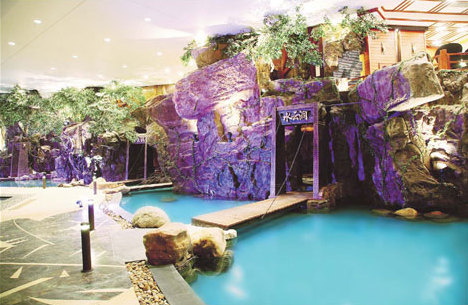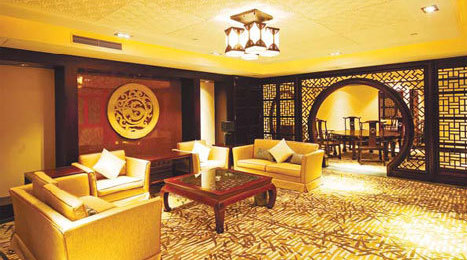Life
Spa caters to 'red mansion' taste
By Han Bingbin (China Daily)
Updated: 2010-07-22 07:53
 |
Large Medium Small |
|
|
The Shunjing Spa Hotel is the self-described world's largest spa resort, at almost 130,000 square meters in size, and is the most luxurious hot spring resort in town. Its hot springs bubble up from 3,075 meters underground. After an elevator takes you down from the entrance lobby to the underground hot springs area, you get to decide the level of luxury you want to enjoy (and pay for).
The whole area has the graceful look of a traditional Chinese garden. A man-made stream, one thousand meters long, wanders through the whole space, like a chain that connects the different areas into a bracelet. Bridges made of wood, stone and white jade arch nicely over the stream. As cobble stone roads lead the way to bridges, visitors strolling about have plenty to take in.
The garden has many plants. Some are artificial giant trees that reach to the ceilings. Others are real flowers hidden in bushes that occasionally stroke visitors' knees.
You cannot see from one end of the garden to the other, because the foliage is so thick. It feels like waking in a labyrinth and it creates the atmosphere of a famous Chinese verse - "behind the dark willows and blooming flowers lies another village".
|
|
The hot spring pools, big or small, round or square, are not easy to see. Some are inside houses, some behind trees, and others are more open because they are exposed to sunlight under a glass ceiling.
On a path leading down to the hot spring area from the entrance, the manager, surnamed Li, suddenly stopped and said, "this is the foot bathing spring."
She pointed at a covered corridor that was not yet complete, but which still had a stream under the roof. Standing in the stream were several sets of stone tables and chairs.
"Later warm mist will rise from below," she said. "Surrounded by the heavenly mist, you can sit on the chair with your feet bathed in the spring while playing chess with friends."
She then pointed to a bird's nest hanging on a tree not far from the corridor. She said the two colorful birds in the nest could imitate human speech.
"Some other birds are kept wild," she said. "I often see them rest on the house beam."
The chirping birds, along with fragrant flowers, create a natural environment, she said.
The stone path soon arrived at a wooden house in front of which stood some cherry blossoms and bamboos.
"It is the Japanese hot spring area," Li said.
Under the warm yellow light, people walked on the warm floor in bare feet. There were two hot spring pools, one of which had water falling on people's shoulders from a trough to help improve neck problems.
Not far away, in a corner, two stone red-crowned cranes sat on cobblestones to remind visitors of the Japanese spirit. Inside there was a Japanese tatami room with a sliding door.
Li said people, after bathing, could lie on the floor in the room which has warm air rising through it.
The light immediately darkened as Li walked into an area beside the Japanese house.
Several giant trees separated the area with a few grass houses from its surroundings. Li approached one grass house and a small hot spring pool came into sight. Under the water, a bulb was giving out yellow light.
"It is cozy and warm, especially good for families," she said.
After several turns and bridges, the strange scent of Chinese herbal soup filled the air.
|
|
A line of rooms appear. Inside each of the room was a small hot spring. Each had a different theme and a distinct smell to match - one was sandalwood, another was chrysanthemum. These are healthy herbal springs.
Waiters stand in every corner of the spa ready to offer cool towels. And there was a tea table made of a giant tree trunk, beside which waitresses were serving famous and expensive teas such as Longjing and Pu'er.
There is also a dessert bar that served high-quality Cantonese desserts such as stewed milk bean curd and guiling jelly. Not far from the dessert bar there was a long beer corridor where two giant tubs serving beers sat fermenting.
The spa also has a number of luxurious gust rooms.
It is a surprise to see the kind of gate depicted in A Dream of Red Mansions show up as the door of a guest room in a hotel.
The gate was mainly painted in bright red, except at the bottom, where there was a piece painted gold and shaped like a calabash. On each side of the gate sat a stone carved with a dragon on the surface.
|
|
As the gate opened, a small yard came in to view, around which were columns painted in bright green. Connecting each column were railings of the same color.
Along the winding corridor, the living room was straight ahead, while on two sides were the bedroom and study room.
All the rooms were furnished in Ming Dynasty (1368-1644) or Qing Dynasty (1644-1911) style, with typical dark brown wooden wardrobes with big bronze locks shaped like clouds.
The tables and chairs were made of the same solid wood and had subtle carvings of auspicious objects. Exquisite vases sat on shelves and the window frames were painted bright red and the lattices in green, completing A Dream of Red Mansions feel.
The manager said they can deliver hot spring water to the bathtub in the room so that guests can enjoy themselves without leaving their accommodation.
The hotel is particularly proud of its 24-hour room service, which includes a butler and day-and-night food delivery.
Such luxury does not come cheap. Staying in the room for one night costs about 12,800 yuan.



